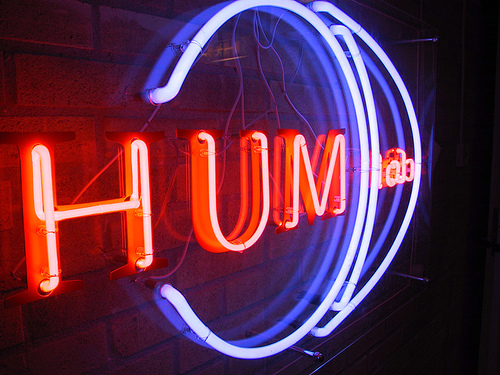We have developed a TAPoRware Analysis Tool Bar that can be embedded in any web page. You will find it floating in the upper right of this page. The tool bar code can be placed in a blog or wiki and edited. See our documentation.
Svensson Talk
Patrick Svensson gave a talk on Friday, December 1st, about visualization and space in humanities computing. (He blogged the visit here.) At the end he showed 3D reconstructions and fly-throughs of the current HUMlab space and the new extended space. The space is optimized for visualization with screens of different sorts around the walls. It is less of a one-person-one-computer lab and more of a collaborative space for encounters.
I blogged this under Research Notes: Patrik Svensson.
Sparklines in TAPoRware
 We are adding sparklines to the TAPoRware tools. We’ve started with the Find Text – Concordance tool. The results include a small graphic distribution sparkline. Now we want to include them in other tools like List Words and comparison tools.
We are adding sparklines to the TAPoRware tools. We’ve started with the Find Text – Concordance tool. The results include a small graphic distribution sparkline. Now we want to include them in other tools like List Words and comparison tools.
Natural Language Toolkit
The Natural Language Toolkit is an open source “suite of program modules, data sets and tutorials supporting research and teaching in computational linguistics and natural language processing.” They also provide corpora for download and experimentation.
Hypertext Fiction Online
afternoon, a story, by Michael Joyce is arguably the first major work of hypertext fiction and is one of those works most critics deal with. This online version is from Hypertext Fiction Selections – part of the Norton site associated with their Postmodern American Fiction: A Norton Anthology (Edited by Paula Geyh, Fred G. Leebron, and Andrew Levy. Norton, 1997.)
Matt K. pointed me to an interesting digression – a report, Hypertext Markets: a Report from Italy, by Walter Vannini, that discusses an Italian translation of afternoon, a story and the state of hypertext fiction in Italy. He draws attention to the proliferation of CD publications. When I was last in Italy I noticed at the newstands a proliferation of hybrid publications – magazines including a DVD or CD. You don’t see that much anymore in Canada.
The interest among mainstream print publishers seems to have settled on electronic titles of a more traditional kind than hypertext, i.e., multimedia, “family entertainment,” and educational/recreational titles, mainly on CD-ROMs. The catalog for such work is fairly rich, even if most of them are quick-and-dirty (and sometimes very dirty) recasts of previously published material. For the moment, most of these titles resemble the worst of documentary television, and require more or less the same amount of interaction (i.e., next to none at all).
Patrik Svensson
 Patrik Svensson Director of HUMlab, Ume?• University, is giving a talk tomorrow here at McMaster.
Patrik Svensson Director of HUMlab, Ume?• University, is giving a talk tomorrow here at McMaster.
In this seminar I will start out from a general discussion of the visual in the humanities and in the digital humanities, and a critique of traditional ‘humanities computing’ which tends to be predominantely textual. I will base my further investigation on several projects from different areas including art history, history, antrophology and linguistics. Key points of discussion include the materiality of interfaces, added values, innovation strategies, and the role of the visualization. Among relevant technologies are geographical information systems, multi-spectral analysis and virtual worlds. Digital culture also gives us highly visual study objects such as computer games, social software and electronic literature, and these will be considered. The final part of the talk deals with physical lab and studio spaces for the digital humanities. How is the visual articulated in such collaborative work spaces? It will be suggested that the humanities may benefit from working with many, individual screens in collaborative settings rather than immersive environments such as CAVEs. HUMlab at Ume?• University will be used a case study and I will describe a planned (and funded!) expansion of the lab which will add thirteen new screens to the studio space.
From the descriptions of the HUMlab it sounds like a creative space – they have paid attention to creating a space where people can meet across the humanities and IT disciplines.
GUIdebook: Graphical User Interface gallery
 GUIdebook: Graphical User Interface gallery is a great resource on the history of GUIs. It has great charts comparing things like component icons for text editors across time and across different GUIs. It documents the evolution of GUIs from the Mac OS to historic ones like the Amiga OS. It has ads, sounds for Windows (like the startup sound) and links to articles. It only has a couple of applications documented (iTunes and Photoshop), but it is still a must see.
GUIdebook: Graphical User Interface gallery is a great resource on the history of GUIs. It has great charts comparing things like component icons for text editors across time and across different GUIs. It documents the evolution of GUIs from the Mac OS to historic ones like the Amiga OS. It has ads, sounds for Windows (like the startup sound) and links to articles. It only has a couple of applications documented (iTunes and Photoshop), but it is still a must see.
Bill O’Reilly Slams PS3 Launch, Gamers, iPods, Digital Tech (not in that order)
 Bill O’Reilly Slams PS3 Launch, Gamers, iPods, Digital Tech (not in that order) is a story with partial transcript on a recent O’Reilly (of the “no spin zone”) rant about technology prompted by the PS3.
Bill O’Reilly Slams PS3 Launch, Gamers, iPods, Digital Tech (not in that order) is a story with partial transcript on a recent O’Reilly (of the “no spin zone”) rant about technology prompted by the PS3.
American society is changing for the worse because of the machines… In the past to flee the real world people usually chose drugs or alcohol… now you don’t have to do that, Now all you have to do is have enough money to buy a machine…
I wonder if TV shows (like the O’Reilly Factor) or books qualify as technologies that are used to flee the real world?
The story is in a blog GamePolitics.com that I just found. Lots of posts on the PS3 launch and related violence.
Don’t Click It: Interaction Research
 www.dontclick.it is a site both about research into interaction (and clicking) and an example of how one doesn’t need to click to interact. You navigate the Flash site using gestures, it discusses the question of clicking and alternatives, and it tracks mouse movement.
www.dontclick.it is a site both about research into interaction (and clicking) and an example of how one doesn’t need to click to interact. You navigate the Flash site using gestures, it discusses the question of clicking and alternatives, and it tracks mouse movement.
There is a nice moment when it asks you a quick survey which, of course, I clicked on, at which point it reminds you not to click.
This is thanks to Nick.
Chirag Mehta: US Presidential Speeches Tag Cloud
US Presidential Speeches Tag Cloud is a sliding series of word clouds for “speeches, official documents, declarations, and letters written by the Presidents of the US between 1776 – 2006 AD.” Chirag Mehta has organized the clouds with time slider so you can move from the latest, “2006-01-31: State of the Union Address” by George W. Bush back to John Adams, “1776-01-15: Foundation of Government”. By moving the slider you can see changes in the high frequency words. Bill Clinton, surprisingly (to me), talked a lot more about families than Bush.
Mehta describes how he generated this at the bottom of the page. Thanks to Gord for this.